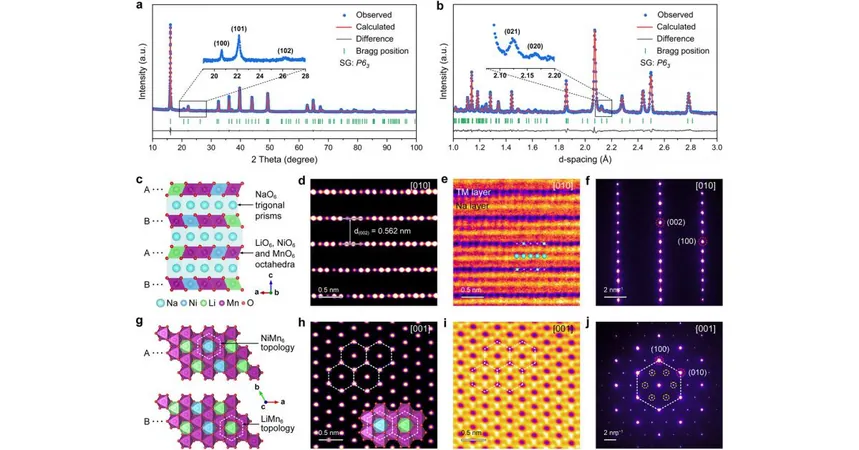
Groundbreaking Bi-Superlattice Breakthrough Promises Longer-Life Sodium-Ion Batteries!
2025-05-23
Author: Yu
Revolutionary Sodium-Ion Battery Technology
A game-changing study published on May 23, 2025, unveils a remarkable leap in sodium-ion battery (SIB) technology. This discovery focuses on achieving highly reversible cationic and anionic redox reactions—crucial elements in realizing batteries with extended life cycles and enhanced energy density.
The Innovative NNLMO Cathode Design
Researchers have crafted a cutting-edge honeycomb-layered cathode material named Na₀.78Ni₀.12Li₀.18Mn₀.7O₂ (NNLMO), featuring a groundbreaking dual-topology NiMn₆/LiMn₆ superlattice. This innovative design stabilizes the oxygen redox process while minimizing structural deterioration. The result? An astonishing reversible capacity of 224 mAh g⁻¹ that retains over 92% capacity after 50 cycles.
Why Sodium-Ion Batteries Are Gaining Traction
As the demand for sustainable and cost-effective energy solutions grows, sodium-ion batteries are emerging as a viable alternative to traditional lithium-ion batteries. However, the challenge remains: achieving high energy density without compromising structural and electrochemical stability. The limitations of layered transition metal oxides, often plagued by irreversible oxygen loss and phase transitions, underscore the urgent need for innovative cathode architectures.
Collaborative Research with Groundbreaking Insights
In a remarkable collaboration between Nankai University and Soochow University, researchers explored the structural behaviors and electrochemical properties of this new P2-type oxide cathode. Using advanced modeling and in situ techniques, they revealed how meticulously tuned atomic arrangements can prevent detrimental changes during battery cycling.
Strategic Innovations in Design
In the NNLMO cathode, Ni²⁺ serves as a redox buffer, while the NiMn₆ superlattice helps disperse the LiMn₆ domains. This setup effectively limits manganese migration and oxygen release, reducing voltage hysteresis by up to 50% compared to standard models, while preventing O₂ gas evolution during operations. Recent spectroscopy and NMR results confirmed the reversible nature of both Mn/Ni and oxygen redox processes.
A Call for Future Research and Commercial Viability
"Our research demonstrates the effectiveness of topological bi-superlattice engineering in tackling long-standing stability issues in oxygen-redox cathodes," states Professor Fangyi Cheng, a leading figure in the study. With this innovative approach, the team has achieved unprecedented redox symmetry and structural endurance in sodium-ion systems.
The dual-topology superlattice approach marks a crucial milestone for the commercial viability of sodium-ion batteries. By addressing key challenges like oxygen instability and structural degradation, the research significantly boosts energy density and cycle life. Future investigations will aim to scale the cathode design for large-format batteries, alongside exploring its adaptability for other electrochemical systems.
The Future of Renewable Energy Storage
This breakthrough holds immense potential for renewable energy applications, promising a new class of sodium-ion batteries that can seamlessly integrate into energy storage solutions and grid systems. Stay tuned as we advance down this exciting path!

 Brasil (PT)
Brasil (PT)
 Canada (EN)
Canada (EN)
 Chile (ES)
Chile (ES)
 Česko (CS)
Česko (CS)
 대한민국 (KO)
대한민국 (KO)
 España (ES)
España (ES)
 France (FR)
France (FR)
 Hong Kong (EN)
Hong Kong (EN)
 Italia (IT)
Italia (IT)
 日本 (JA)
日本 (JA)
 Magyarország (HU)
Magyarország (HU)
 Norge (NO)
Norge (NO)
 Polska (PL)
Polska (PL)
 Schweiz (DE)
Schweiz (DE)
 Singapore (EN)
Singapore (EN)
 Sverige (SV)
Sverige (SV)
 Suomi (FI)
Suomi (FI)
 Türkiye (TR)
Türkiye (TR)
 الإمارات العربية المتحدة (AR)
الإمارات العربية المتحدة (AR)